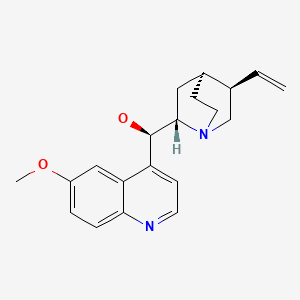Attribution Statement: LactMed is a registered trademark of the U.S. Department of Health and Human Services.
NCBI Bookshelf. A service of the National Library of Medicine, National Institutes of Health.
Drugs and Lactation Database (LactMed®) [Internet]. Bethesda (MD): National Institute of Child Health and Human Development; 2006-.
CASRN: 130-95-0

Drug Levels and Effects
Summary of Use during Lactation
Because of the low levels of quinine in breastmilk, amounts ingested by the infant are small and would not be expected to cause any adverse effects in breastfed infants. The dosage in milk is far below those required to treat an infant for malaria.[1] However, quinine should not be used in mothers with an infant who is glucose-6-phosphate dehydrogenase (G6PD) deficient.[2] Even the relatively small amounts of quinine in tonic water ingested by the mother have caused hemolysis in G6PD-deficient infants.
Drug Levels
Maternal Levels. One old study measured quinine levels in the milk of 6 women at varying times after 2 to 3 doses of 300 or 640 mg of quinine.[3] Milk levels ranged from traces to 4.4 mg/L, with an average of about 0.8 mg/L. The time of peak milk levels varied from 1.5 to 6.4 hours after the dose.
An unpublished study found that milk levels approximated one-third of simultaneous plasma levels. The author estimated that an infant would receive 1.5 to 3 mg daily of quinine base with maternal treatment.[4]
One group of investigators studied 30 women who received quinine while breastfeeding intravenously or orally. Two publications reported data from the same group of women. In one paper, the milk levels reported after intravenous quinine appeared to be the levels following oral quinine and vice versa.[5] This was apparently corrected in the later publication which is summarized as follows: twenty-five women received quinine sulfate 600 mg every 8 hours orally for 7 days had random breastmilk quinine levels averaging 2.6 mg/L (range 0.5 to 3.6 mg/L). In 3 of the women who had just initiated lactation, colostrum levels were 0.4, 0.9 and 1.9 mg/L. Five women who received a daily dosage of quinine dihydrochloride 10 mg/kg (8.3 mg/kg of quinine base) intravenously for 2 to 7 doses had random breastmilk quinine levels averaging 3.4 mg/L (range 0.5 to 8 mg/L).[6]
Infant Levels. Relevant published information was not found as of the revision date.
Effects in Breastfed Infants
Four breastfed infants of 3 mothers, 3 boys and 1 girl (one set of twins) developed severe hemolysis following maternal ingestion of beverages containing quinine (e.g., tonic water). All infants had low levels of G6PD and were jaundiced on admission. Cessation of breastfeeding and tonic water and phototherapy and/or transfusion resolved the jaundice. One of the infants who was severely jaundiced had abnormal brainstem automatized evoked potentials at discharge. At 4 months of age he had a slight decrease in reactivity and a profound bilateral deafness. The breastmilk of one of the mothers was qualitatively positive for quinine.[7] The hemolysis was probably caused by quinine in breastmilk.
Effects on Lactation and Breastmilk
Relevant published information was not found as of the revision date.
Alternate Drugs to Consider
References
- 1.
- Fulton B, Moore LL. Antiinfectives in breastmilk. Part II: sulfonamides, tetracyclines, macrolides, aminoglycosides and antimalarials. J Hum Lact. 1992;8:221–3. [PubMed: 1288560]
- 2.
- Mathew JL. Effect of maternal antibiotics on breast feeding infants. Postgrad Med J. 2004;80:196–200. [PMC free article: PMC1742963] [PubMed: 15082839]
- 3.
- Terwilliger WG, Hatcher RA. The elimination of morphine and quinine in human milk. Surg Gynecol Obstet. 1934;58:823–6.
- 4.
- White NJ. Clinical pharmacokinetics of antimalarial drugs. Clin Pharmacokinet. 1985;10:187–215. [PubMed: 3893840]
- 5.
- Phillips RE, Looareesuwan S, White NJ, et al. Quinine pharmacokinetics and toxicity in pregnant and lactating women with falciparum malaria. Br J Clin Pharmacol. 1986;21:677–83. [PMC free article: PMC1400988] [PubMed: 3527243]
- 6.
- Looareesuwan S, White NJ, Silamut K, et al. Quinine and severe falciparum malaria in late pregnancy. Acta Leidensia. 1987;55:115–20. [PubMed: 3321826]
- 7.
- Bichali S, Brault D, Masserot C, et al. Maternal consumption of quinine-containing sodas may induce G6PD crises in breastfed children. Eur J Pediatr. 2017;176:1415–8. [PubMed: 28828525]
Substance Identification
Substance Name
Quinine
CAS Registry Number
130-95-0
Drug Class
Breast Feeding
Anti-infective Agents
Antiparasitic Agents
Antimalarials
Antiprotozoal Agents
Foodborne Diseases
Glucosephosphate Dehydrogenase Deficiency
Disclaimer: Information presented in this database is not meant as a substitute for professional judgment. You should consult your healthcare provider for breastfeeding advice related to your particular situation. The U.S. government does not warrant or assume any liability or responsibility for the accuracy or completeness of the information on this Site.
- User and Medical Advice Disclaimer
- Drugs and Lactation Database (LactMed) - Record Format
- LactMed - Database Creation and Peer Review Process
- Fact Sheet. Drugs and Lactation Database (LactMed)
- Drugs and Lactation Database (LactMed) - Glossary
- LactMed Selected References
- Drugs and Lactation Database (LactMed) - About Dietary Supplements
- Breastfeeding Links
- PMCPubMed Central citations
- PubChem SubstanceRelated PubChem Substances
- PubMedLinks to PubMed
- Review Quinidine.[Drugs and Lactation Database (...]Review Quinidine.. Drugs and Lactation Database (LactMed®). 2006
- Review Primaquine.[Drugs and Lactation Database (...]Review Primaquine.. Drugs and Lactation Database (LactMed®). 2006
- Review Codeine.[Drugs and Lactation Database (...]Review Codeine.. Drugs and Lactation Database (LactMed®). 2006
- Review Alcohol.[Drugs and Lactation Database (...]Review Alcohol.. Drugs and Lactation Database (LactMed®). 2006
- Maternal consumption of quinine-containing sodas may induce G6PD crises in breastfed children.[Eur J Pediatr. 2017]Maternal consumption of quinine-containing sodas may induce G6PD crises in breastfed children.Bichali S, Brault D, Masserot C, Boscher C, Couec ML, Deslandes G, Pissard S, Leverger G, Vauzelle C, Elefant E, et al. Eur J Pediatr. 2017 Oct; 176(10):1415-1418. Epub 2017 Aug 21.
- Quinine - Drugs and Lactation Database (LactMed®)Quinine - Drugs and Lactation Database (LactMed®)
Your browsing activity is empty.
Activity recording is turned off.
See more...
